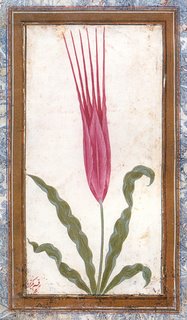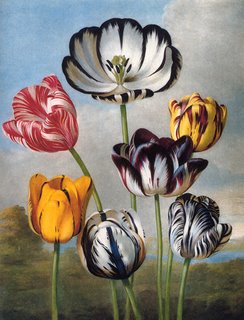The Tulip Memorial
I, Linda, just finished reading Anna Pavord's The Tulip, courtesy of Nada - gorgeously illustrated book detailing the history of, you guessed it, the tulip (which incidentally, was apocryphally misnamed by Belgian bloke Ogier Ghiselin de Busbecq in the 16th Century - Oggy pointed to a Turkish chap's turban and asked him the name of the flower tucked in it - said chap answered "tulband" which means 'turban' and we've been stuck with the name ever since. (In Turkish, the tulip was a 'lale'). The Turks thought tulips should look like this:

Oh fickle fashion! The Dutch decided they loved the crazy flamed and feathered tulips that looked like this...

...and they paid a fortune for them - who needs a mansion in Amsterdam when you can have a single tulip bulb? "What?" I hear you say. "Tulips don't look like that!" And you'd be right. The reason tulips did look like these (with hundreds of variations) is a virus spread by aphids. Not that anyone discovered that until about 1920, when the tulip fashion had changed again and no one cared anymore. Nowadays nearly all tulip growers eliminate these so-called "broken" tulips from their crops (did you know that HALF of Holland's land mass is dedicated to the growing of tulips?) and so it seems does everyone else.
Determined to procure some flaming beauties for myself, I scoured the Internet and came across the delightful people from Old House Gardens. This is what they told me;
Hi Linda,
I'm glad that you enjoyed Anna's book. If you're interested in knowing more about Tulipomania you might be interested in Mike Dash's "Tulipomania" as well. Anna is mostly correct. Broken tulips are no longer commercially available. However, we still carry the broken tulips, and so do two other companies in the world. All broken tulips that are currently being sold are all from the historic collections at the Hortus Bulborum in the Netherlands which is a historic botanic garden in the Netherlands. The tulip breaking virus is still in their stock of broken tulips, but it is somewhat segregated from the main production fields of flowers that is the Netherlands top agricultural pursuit.
http://www.oldhousegardens.com/hortus.asp
http://www.hortus-bulborum.nl/
Broken tulips (English Florist tulips) are also still wildly popular with the Wakefield and North of England Tulip Society in England. They have small supplies which they will share with friends and other interested parties, they are just not commercially available.
http://www.tulipsociety.co.uk/
I hope this gives you a little more hope that these precious flowers still exist, however, they are going to be almost impossible to get to you in Australia. I hope that you can take a little solace in knowing that they are still being grown. If you ever get the chance to visit the Netherlands in April, be sure to take some time to visit the Hortus Bulborum.
Sincerely,
Rachel Murphy
Old House Gardens.
Nada, however, seems to have discovered that lovely virus in Australia...


Oh fickle fashion! The Dutch decided they loved the crazy flamed and feathered tulips that looked like this...

...and they paid a fortune for them - who needs a mansion in Amsterdam when you can have a single tulip bulb? "What?" I hear you say. "Tulips don't look like that!" And you'd be right. The reason tulips did look like these (with hundreds of variations) is a virus spread by aphids. Not that anyone discovered that until about 1920, when the tulip fashion had changed again and no one cared anymore. Nowadays nearly all tulip growers eliminate these so-called "broken" tulips from their crops (did you know that HALF of Holland's land mass is dedicated to the growing of tulips?) and so it seems does everyone else.
Determined to procure some flaming beauties for myself, I scoured the Internet and came across the delightful people from Old House Gardens. This is what they told me;
Hi Linda,
I'm glad that you enjoyed Anna's book. If you're interested in knowing more about Tulipomania you might be interested in Mike Dash's "Tulipomania" as well. Anna is mostly correct. Broken tulips are no longer commercially available. However, we still carry the broken tulips, and so do two other companies in the world. All broken tulips that are currently being sold are all from the historic collections at the Hortus Bulborum in the Netherlands which is a historic botanic garden in the Netherlands. The tulip breaking virus is still in their stock of broken tulips, but it is somewhat segregated from the main production fields of flowers that is the Netherlands top agricultural pursuit.
http://www.oldhousegardens.com/hortus.asp
http://www.hortus-bulborum.nl/
Broken tulips (English Florist tulips) are also still wildly popular with the Wakefield and North of England Tulip Society in England. They have small supplies which they will share with friends and other interested parties, they are just not commercially available.
http://www.tulipsociety.co.uk/
I hope this gives you a little more hope that these precious flowers still exist, however, they are going to be almost impossible to get to you in Australia. I hope that you can take a little solace in knowing that they are still being grown. If you ever get the chance to visit the Netherlands in April, be sure to take some time to visit the Hortus Bulborum.
Sincerely,
Rachel Murphy
Old House Gardens.
Nada, however, seems to have discovered that lovely virus in Australia...

Ahh...the tulips. I bought a few when I moved to my house in the Blue Mountains. Cool climate - perfect tulip country. A few coloured ones..bit of this, bit of that. Gardening with no real plan. Some in pots, others in the ground. They were a very welcome sight after the grey winter - even attracting some bees. Something curious happened. One yellow tulip had a flame of red. A crack. It looked good. I liked it. When they died down I lifted them and stored them to plant out the following autumn.
Being a novice gardener, I began to read gardening books. A lot of gardening books. I read Michael Pollan's "The Botany of Desire" which lead me to Anna Pavord. After reading that I became tulip obsessed. I learnt about the broken tulip and hoped that my yellow tulip was indeed such an item. I ordered more tulips for the autumn...planted out the collection and waited. There were more of them....they looked beautiful but were infected. A crisis ensued. Should I mark them? Should they be separated? Was it fair to keep planting them out among the healthy bulbs, knowing they would infect the others? What was I to do? Look to Nietzsche for answers?
I did mark them out but I'd decided to keep them, to plant them in pots, where they could still be enjoyed. An imperfect solution but the lure of their beauty, the element of chance, the thrill....I began to understand the Dutch tulip madness.
The foliage of the tulips died down, I dutifully performed the lifting and storing, being mindful to keep the infected ones seperated and put them in assorted thick paper bags. I stored them on a shelf under the house.
Now where we live, borders the National Park...there is native fauna.....possums regularly get in under my house - they scamper about, hiss and breathe in a very creepy way. We don't usually mind but come tulip planting time, the following year, I began to revise my feelings about the possums. These creatures had eaten all the bulbs.....and left their droppings as a calling card. It was a tasty feast for them. Gardening was revealing itself to be full of these conundrums. Leisure activity. Ha!
So these pictures are all that's left of those first tulips. I finally got over it and did order some other tulips but have never had the "crack"/ break" since. I live in hope....

Being a novice gardener, I began to read gardening books. A lot of gardening books. I read Michael Pollan's "The Botany of Desire" which lead me to Anna Pavord. After reading that I became tulip obsessed. I learnt about the broken tulip and hoped that my yellow tulip was indeed such an item. I ordered more tulips for the autumn...planted out the collection and waited. There were more of them....they looked beautiful but were infected. A crisis ensued. Should I mark them? Should they be separated? Was it fair to keep planting them out among the healthy bulbs, knowing they would infect the others? What was I to do? Look to Nietzsche for answers?
I did mark them out but I'd decided to keep them, to plant them in pots, where they could still be enjoyed. An imperfect solution but the lure of their beauty, the element of chance, the thrill....I began to understand the Dutch tulip madness.
The foliage of the tulips died down, I dutifully performed the lifting and storing, being mindful to keep the infected ones seperated and put them in assorted thick paper bags. I stored them on a shelf under the house.
Now where we live, borders the National Park...there is native fauna.....possums regularly get in under my house - they scamper about, hiss and breathe in a very creepy way. We don't usually mind but come tulip planting time, the following year, I began to revise my feelings about the possums. These creatures had eaten all the bulbs.....and left their droppings as a calling card. It was a tasty feast for them. Gardening was revealing itself to be full of these conundrums. Leisure activity. Ha!
So these pictures are all that's left of those first tulips. I finally got over it and did order some other tulips but have never had the "crack"/ break" since. I live in hope....

1 Comments:
I want to grow tulips now. See how impressionable I am?
There's a nice snippet about Tulipomania over at the AKS.
Post a Comment
<< Home